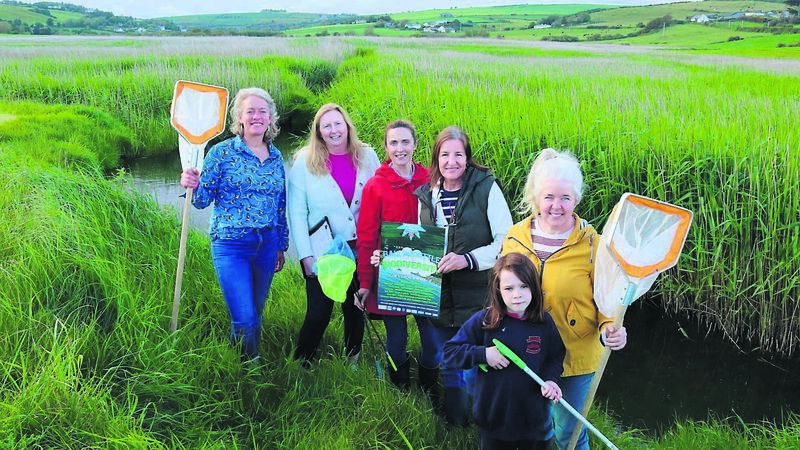Women for Wetlands in Cork are on a mission

Women for Wetlands members, Katie McShane - Wise Water - Educational Workshop Practitioner Alayne Hayes - Outdoor Educational Instructor Fiona Prederville - Archaeologist Karla Goodman - MtM Films - Producer/Director Danwa Connolly - Environmental Activist.
WHEN most of us Corkonians think of Garrylucas and Garretstown, hot summer days at the beach spring to mind.
This beachside locality is enjoyed by people of all ages, who participate in activities from surfing to swimming, building sandcastles, saunas, and leisurely walks. It’s a natural resource from which we all benefit and contributes to the local economy’s success.
But for a local group of environmental activists, the area has much more to offer by way of natural capital - the local marshes at Garrylucas and Garrettstown - that urgently require our attention.
Alayne Hynes explained: “It was probably back around Covid, maybe 2020. We did a SECAD sustainable communities training online, a group of us from the locality.”
This course proved fruitful, giving rise to the Courcey Sustainability Group and, in time, Women for Wetlands, a West Cork group of women environmental activists. The group was forged and sprung into action to protect local wetlands from the threat of damage.
The Women for Wetlands group comprises of 26 members, an eclectic mix of women from different backgrounds, entrepreneurs, filmmakers, sports enthusiasts, artists, young mums, and farmers. They aim to get the proposed Natural Heritage wetlands at Garretstown and Garrylucas beaches fully protected under Irish Law (currently only proposed). They also want others to enjoy the bounty of nature in these wetlands and have a vision to make them a jewel in the Wild Atlantic Way - with bird-watching look-outs and signage for the public to appreciate what lies beyond.
It’s a vision that makes sense for many reasons, yet the women face a considerable barrier to transforming these locations from proposed Natural Heritage Areas to legally protected sites: bureaucracy.
Katie McShane highlights the realities of a stagnant process: “There are about 600 of these proposed National Heritage Areas (NHA) that are gathering dust in a government office. Nobody’s taking responsibility to sign them off, and it’s very hard to get these NHAs into legislation.
What’s happening is that they are becoming damaged in the long waiting process.
The group have taken a two-pronged approach to achieving their goals.
Karla Goodman explained: “We’ve been advised to go at it several ways, and one of them was education, which is what we’re planning through the Biodiversity Week (running from May 17 to 26). We have the perfect location to do talks and classes, forest schools, and so on.
“The other way was to get support in terms of getting the land looked at and to become a properly protected heritage area.”
They have a jam-packed schedule with something for everyone for biodiversity week, from a ‘Leave Less Waste’ workshop, river species identification, wildlife photography and a colouring in art competition, a forest scavenger hunt, culminating in a Wetlands Celebration Day on Sunday, May 26, with a Wetland Educational Talk by ecologist, Pascal Sweeney. Some members of this group have already achieved considerable success with a petition back in 2020 focused on protecting the biodiversity in the Kilcoleman Bog, also known as Garrylucas Marsh.
Their work and the signatures of many others resulted in the bog being protected as a Wetland Habitat under the Planning and Development Act and listed as a Proposed Natural Heritage Area.
The win achieved from this initial petition shows the power of a united stance, creating much-needed progress for conservation.
However, with the habitat under threat, they have had a new petition since October, 2023, with almost 1,000 signatures already. More names are needed to push this important agenda and make those in power sit up and act on this time-sensitive issue.
This new petition “urges local authorities and environmental bodies to renew their focus on protecting Kilcoleman Bog by implementing effective conservation strategies. Let us come together as a community to protect our local wildlife, heritage, and nature and, in doing so, safeguard our community from future flooding.”
Flooding is a theme that is becoming an increasingly big challenge in this locality, and members are quick to share that protecting wetlands not only protects this unique ecosystem of diverse inhabitants, but also protects the community from flooding and is a highly effective carbon sink.
Dawna Connolly is a strong advocate for the considerable benefits the wetlands confer. She said: “They’re much more efficient at carbon-storing and carbon sinking than forests are. It is so important to Ballinspittle in terms of flood mitigation, as our village is a low-lying, flood-prone area, and if we don’t have that marsh soaking all the water up, it’s going to lead to huge problems further down the line.
That whole (wetland) area is like a huge sponge. It protects the Old Head from becoming an island, and I don’t think that’s anything people are aware of.
Education is another focus of the group, and it aims to create an understanding within and beyond their community of the wetlands’ worth, hosting several events to educate and advocate for the protection of these local natural assets.
Dawna said: “Nobody thinks about leaving these swampy bits at the bottom (of the field). They’re just seen as unused land. And we really have to change that mindset.”
Katie McShane speaks with enthusiasm about the actions they have taken.
“We’re kick sampling to check the life in the river and bringing the kids in and getting the kids involved because it’s a really exciting way to see what’s there, and there is a lot more living in there than you’d realise by just looking at it. That’s a very important part of our group, interacting with the community and getting a bit of energy and curiosity.”
She muses that “the work within the group starts at the river in the village and, interestingly, we’ve made our way from the village to the sea where it is.”
The statistics around wetlands make for stark reading, as Fiona Prenderville shared.
Only 1% of the bogs in Europe are remaining, and most of them are in Ireland. We are still cutting, burning and draining our bogs in Ireland… Regardless of what species are there, we should be protecting every little bit of wetland left out there.
But why the urgency? Karla sums it up succinctly; “When it’s gone, it’s gone. So now is the time to do something about it.”
She speaks with sadness about the shifting baselines that may result in future generations growing accustomed to life without the sound of the curlews, without sand martins on the beach, without marsh flowers.
“When it’s gone, people of a certain generation won’t notice it was ever there,” said Karla.
Women for Wetlands welcomes new members, and Karla explained how volunteering can not only ease eco-anxiety but create a personal sense of purpose.
“Just being amongst these amazing and committed women, and us all working towards the same goal, is a great way to placate that sense of helplessness, to form a lovely warm bond, and really feel that you are making a difference.”
They are particularly keen to recruit members with specific expertise in ecology and IT to add to the existing strengths of this diverse group.
Most of all, they are looking for signatures to give their petition the people power it needs to command attention and become a lever for change. Taking far less time than it takes to read this article, it is a small ask to help protect one of Cork’s underappreciated natural areas.
Go to change.org and search for Protect and Preserve Kilcoleman Bog / Garrylucas Beach, Ballinspittle, Co Cork
For more information on the group and its Biodiversity Week events, see the Ballinspittle Bumbles(biodiversity group) Facebook page: Ballinspittle Bumbles (biodiversity group)







 App?
App?


